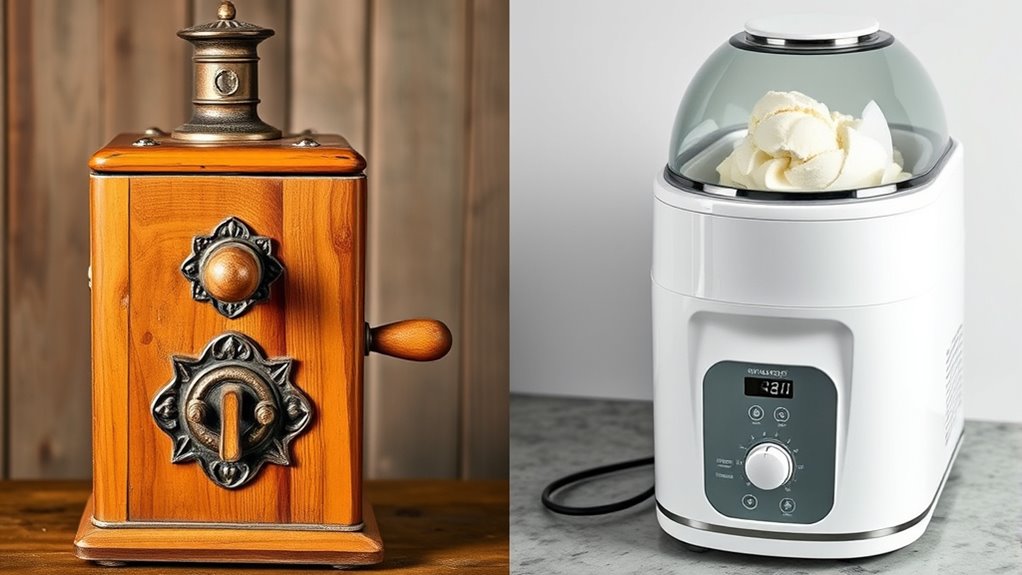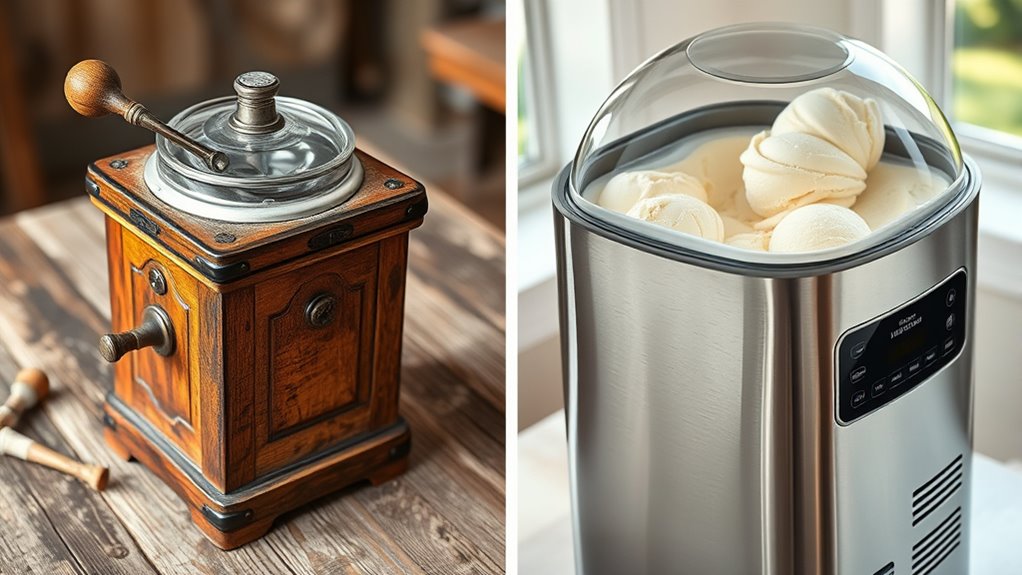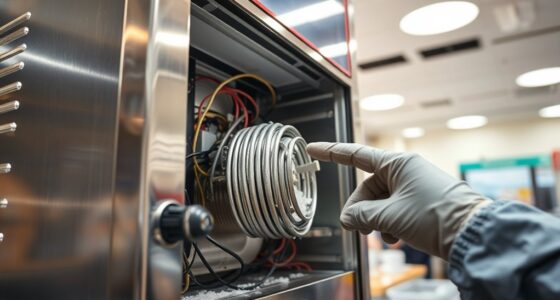Ice cream makers have come a long way from manual, hand-crank devices that demanded effort and patience. Today, automatic models feature built-in motors, digital controls, and precise temperature regulation, making ice cream making quick and effortless. Modern appliances offer consistent results with less skill required, focusing on convenience and quality. If you want to discover how these innovations transformed ice cream making, there’s plenty more to explore below.
Key Takeaways
- Early models relied on manual hand crank operation, requiring physical effort and patience.
- Modern ice cream makers feature automatic motors, digital controls, and pre-freeze bowls for convenience.
- Technological advances include precise temperature control and built-in compressors, eliminating pre-freezing steps.
- Ease of use has improved significantly, with user-friendly interfaces and consistent results for casual and serious users.
- Overall, the evolution has shifted from manual labor to high-tech automation, prioritizing speed, quality, and accessibility.

Ice cream makers have come a long way from their humble beginnings, transforming how we enjoy this beloved treat. Early models relied heavily on hand crank designs, requiring you to manually turn a handle for extended periods to churn the mixture. This process could be tiring, especially if you wanted to make a large batch or if you simply didn’t have the stamina for constant cranking. These manual devices often featured a simple bucket or tub with a paddle attached to a crank handle, forcing you to put in physical effort to achieve the smooth, creamy texture we associate with good ice cream. While effective, they demanded patience and physical work, which could discourage casual users or those short on time.
Today, the landscape of ice cream makers has shifted dramatically with the advent of automatic features. Modern machines take much of the effort out of the process. Instead of manually turning a crank, you just pour your ingredients into the machine, select the desired setting, and let the appliance do the work. These automatic models incorporate built-in motors, timers, and sometimes even digital controls, allowing you to set it and forget it. This not only makes the process more convenient but also more consistent, as automatic features help maintain the *best* churning speed and temperature. Many models now include pre-freeze bowls, which eliminate the need for pre-freezing the entire unit. You simply keep the bowl in your freezer, and when you’re ready, it’s ready to go, cutting down on preparation time *considerably*. Pre-freezing technology has significantly improved the efficiency of ice cream production.
Furthermore, some advanced models feature precise temperature control, which ensures optimal texture and prevents ice crystal formation, enhancing overall quality. In addition, newer ice cream makers boast features like programmable timers, auto shut-off, and even built-in compressors that eliminate the need to pre-freeze bowls altogether. These advancements mean you can produce ice cream with minimal effort, in less time, and with less guesswork. The *shift* from hand crank designs to automatic features reflects a broader *change* toward user convenience and precision. Additionally, user-friendly controls make it easier for anyone to operate these appliances without prior experience. Furthermore, some models now incorporate advanced cooling technology that ensures optimal freezing performance and texture consistency. You may also find some models equipped with resources and tools designed to help you achieve perfect results every time. You no longer need to exert physical effort or plan hours ahead; instead, you can enjoy freshly made ice cream in a fraction of the time. Whether you’re a casual home chef or a serious ice cream enthusiast, these innovations make the process more accessible and enjoyable. So, from manual cranking to high-tech automation, the evolution of ice cream makers caters to your desire for simplicity, speed, and perfect results every time.
Frequently Asked Questions
What Materials Were Early Ice Cream Makers Typically Made From?
Early ice cream makers were typically made from historical materials like wood, metal, and tin, reflecting the manufacturing techniques of their time. You can see how these materials were chosen for durability and ease of use. These traditional methods relied on hand-cranking and basic construction, which contrasts sharply with modern electric models. Understanding the materials helps you appreciate the craftsmanship and technological progress that shaped ice cream making through the ages.
How Did Manual Ice Cream Makers Operate Before Electricity?
You used a manual churn to make ice cream before electricity, turning a handle to agitate the mixture. This process relied on a manual churn, which helped incorporate air and prevent ice crystals. You would place a mixture in the churn, surround it with crushed ice and salt, and then rotate the handle. The ice block freezing provided the cool environment needed, making homemade ice cream a fun, labor-intensive activity.
What Innovations Have Improved Ice Cream Texture Over Time?
Did you know that modern ice cream texture improvements have increased customer satisfaction by over 25%? You’ll notice that innovations like enhanced churning methods, better cooling technology, and ingredient preservation techniques have made your favorite treats creamier and smoother. These advancements help maintain ideal ingredient quality, giving you a richer flavor and better consistency with every scoop. Thanks to these innovations, you now enjoy ice cream that’s fresher, more indulgent, and perfectly textured.
Are Modern Ice Cream Makers Energy-Efficient Compared to Older Models?
You’ll find that modern ice cream makers are more energy-efficient than older models, thanks to advances in technology. They consume less energy, reducing your environmental impact and lowering electricity bills. These newer appliances often feature better insulation and smarter motors, making them more eco-friendly. By choosing updated models, you help conserve resources while still enjoying delicious ice cream at home.
How Has the Capacity of Ice Cream Makers Changed Throughout History?
Imagine a growing ice cream scoop, symbolizing capacity evolution. Over time, historical trends show makers increasing in size, allowing you to prepare larger batches effortlessly. Early models were smaller, suited for personal use, but today’s machines cater to families and commercial needs. This capacity evolution reflects technological advancements, making it easier for you to serve more ice cream quickly, aligning with your desire for efficiency and convenience.
Conclusion
Imagine stepping into a kitchen decades ago, where churning ice cream was a messy, manual task. Today, with just a button press, you can enjoy creamy perfection in minutes. Like the evolution of ice cream makers, technology transforms simple dreams into effortless realities. You’re now part of that sweet journey, where innovation turns hard work into delightful indulgence, making every scoop a demonstration of progress—frozen moments of joy delivered at your fingertips.










